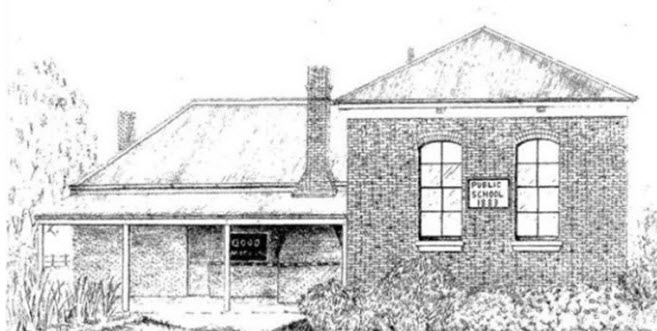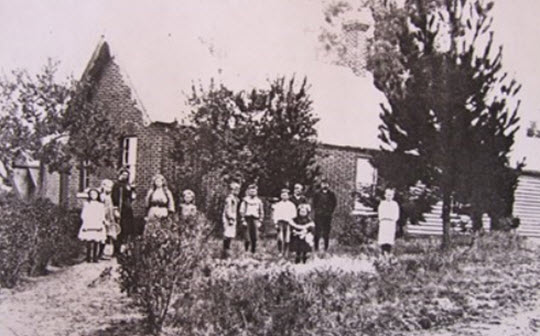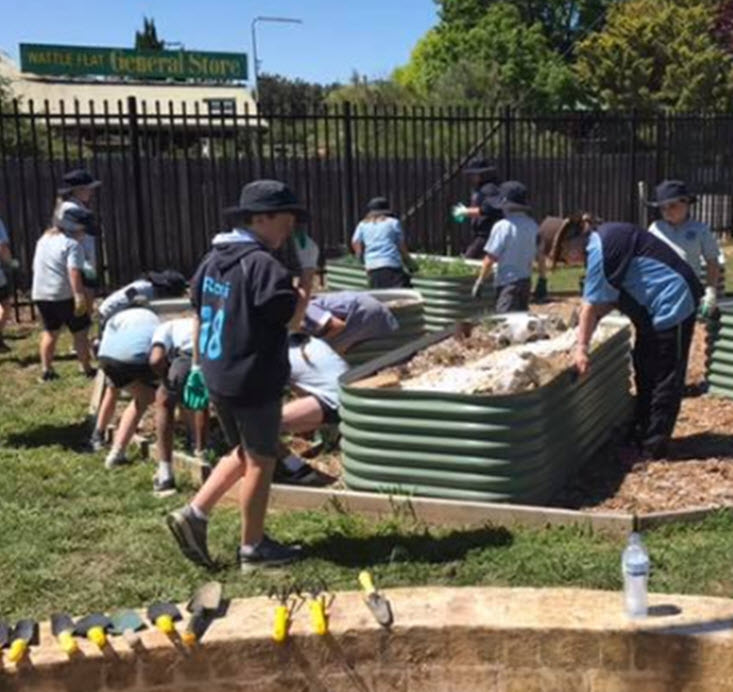The Schools of Wattle Flat (1854-2018)

The brick Public School building. Older 1872 part on left & 1883 part on right. Still operating today.

The brick St Joseph’s Convent building opened in 1876, and closed in 1959.
There have been two larger schools in Wattle Flat, both with student numbers that have exceeded 100 at peak attendance. These schools are the Wattle Flat Public School and the St Joseph’s Convent School. There are mentions of a tiny private school being established in a shed at the back of Beath’s Prospect Inn during the earliest years of Wattle Flat (1854-1857).
The first major school development was initiated by the colonial government in 1857, 6 yrs after the onset of the Gold Rush in 1851. A timber slab building was erected on the site of the present Public school and the 1st teacher was a Scotsman named Mr Hume. In 1866 Irish catholic teachers Mr Maloney & Mr Donnelly were teaching at this school.
During the 1860’s & 70’s, education in the colony was a controversial, and intensively debated subject for the government & social leaders in these formative years of nationhood.
At the end of 1866 the colonial government brought in new laws regarding education with the passing of the Public Schools Act of 1866. This Act was fostered by Sir Henry Parkes who is sometimes referred to as the father of Australian Federation.
Prior to the 1866-Public Schools Act, the colonial education system was administered by a complicated system involving a National Schools Board and the Denominational Schools Board.
The 1866 Act & successive Acts attempted to adhere to 3 central themes:
- That Education was Free
- That Education was Compulsory
- That Education was Secular (ie. not associated with religious or spiritual matters)
The Catholic Church felt particularly challenged by this new legislation by a government that seemed oriented toward Protestantism. The 1866 Act minimised state funding for denominational schools, especially those in remote areas. Catholic families resisted sending their children to the new post 1866 Public Schools. There was a movement toward the creation of new catholic schools even though minimal government assistance would be forthcoming.
At this time, an accomplished scientist in South Australia, who was also a catholic priest started to put some emerging ideas together. His name was Father Julian Tenison-Woods. Over his career he researched and published many scientific papers on geology, zoology and botany and later became president of the NSW Linnaean Society. In 1867 he met and befriended young Mary McKillop at Penola , South Australia. Together they hatched a plan to provide low cost education for catholic children in remote areas. They initiated the congregation of The Sisters of St Joseph, an unorthodox community of nuns dedicated to the education of children.
In the early 1870’s, as Wattle Flat experiences a gold rush revival and the population surges again, both the Public School and a future Catholic school are in the spotlight. The colonial government builds a new brick Public School building (old part) and teacher’s residence alongside, which still stand today. In 1872, 45 students are attending this Public School.
On a mission to Wattle Flat in 1870, Father Tenison-Woods promises teaching sisters for a new Wattle Flat Catholic School. Initially two timber rooms are built on the back of the Catholic Church as accommodation for the sisters, the church itself being used as a teaching space. Next, Wattle Flat farmer, Mr A White provides locally made bricks for the construction of “The Sacred Heart Convent School”. In 1876 with the brick convent completed, the Sisters of St Joseph formally start teaching with over 100 students.
The Wattle Flat Public School, records 150 students attending in 1881 in a structure too small to contain them. In 1883 this school is expanded with the construction of a beautiful larger brick hall in front of the older brick building. In 1891 Mr Charles Grater is appointed as head teacher at the Wattle Flat Public School. He remains enthusiastically teaching at this school for 32 years until his transfer to another community in 1923. Over these years Mr Grater nurtured local sporting clubs, and took leadership roles in community representation. Among his recorded projects are a popular & controversial tableaux concert in 1910 and his school excursion to the Greenman oil distillation plant in 1913.
In 1936, the Wattle Flat St Joseph Convent celebrates its Diamond Jubilee, 60 years of continuous teaching by the sisters. Keeping pace with business technology, the convent proudly reports in the newspapers, the results of their students in shorthand & typewriting in 1904 & 1921 respectively. In 1936 the student numbers had then reduced to between 20 & 30, but this school continues until eventual closure in 1959.
Both of these Wattle Flat schools pride themselves with their elaborate annual concerts held in the village halls, for the popular entertainment of villagers, and fund raising for the schools & other causes. Collaboration between these schools is evident in the sharing of scarce resources.
The Wattle Flat Public School continues strongly to the present day, and currently has 28 students. Recent activities, videos & photos of the school can be seen on the schools Facebook site : https://www.facebook.com/WattleFlatPS . Modern classrooms have been built, the students attend excursions and have fascinating special interest visitors.
Leaping into an exciting future in September 2018, students of Wattle Flat Public School were introduced to hi-tech kits via the NSW Government STEMShare community program. The kits include robotics, 3D printing, & virtual reality equipment .


